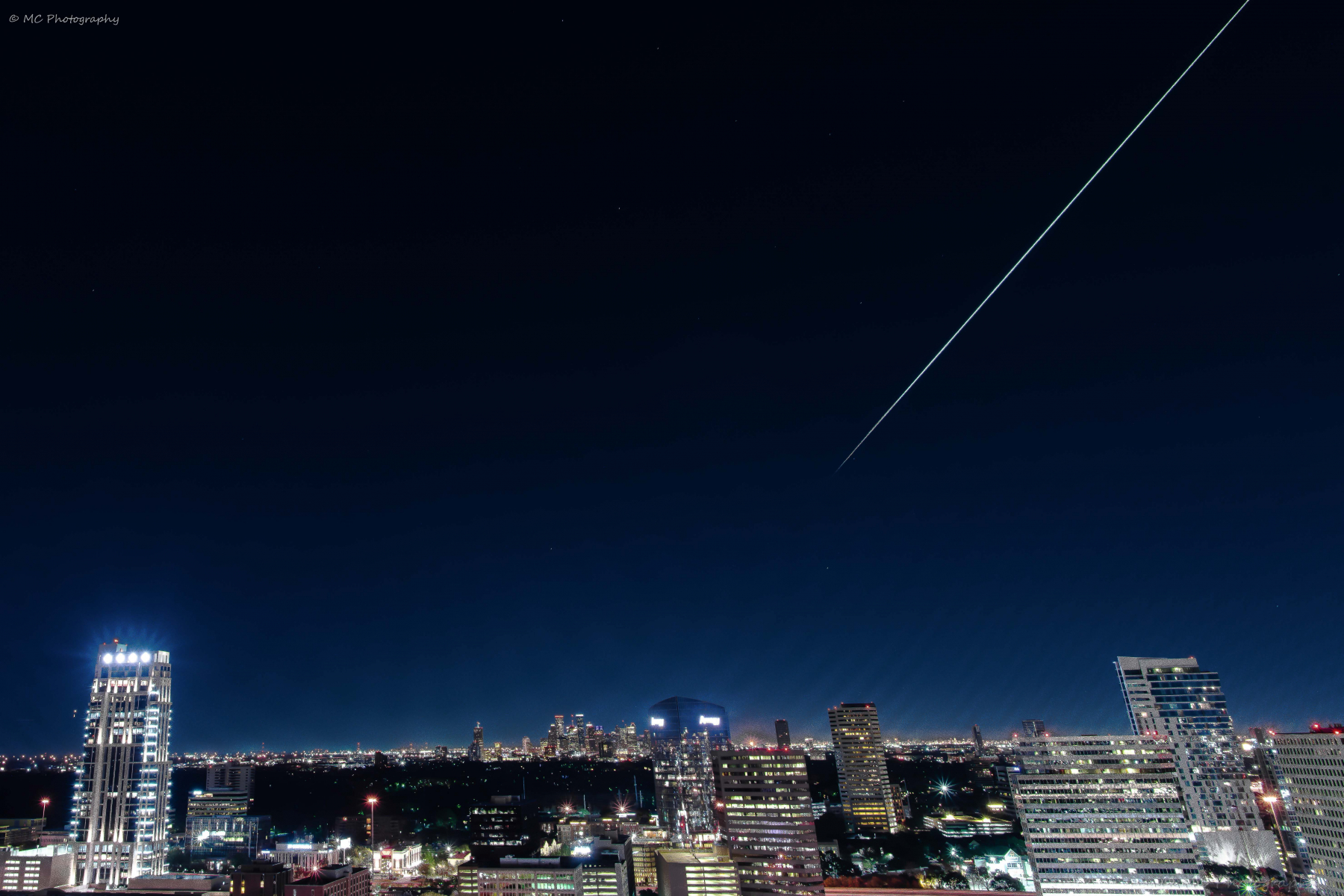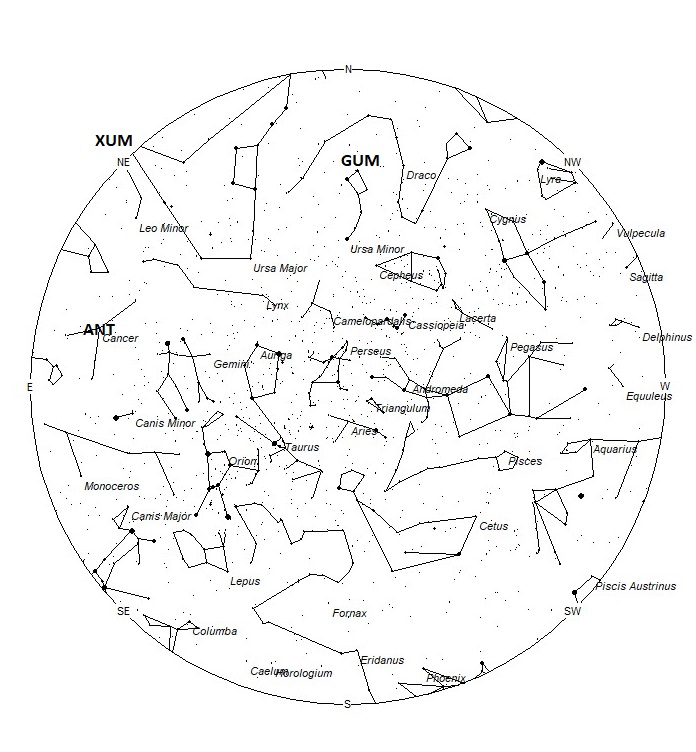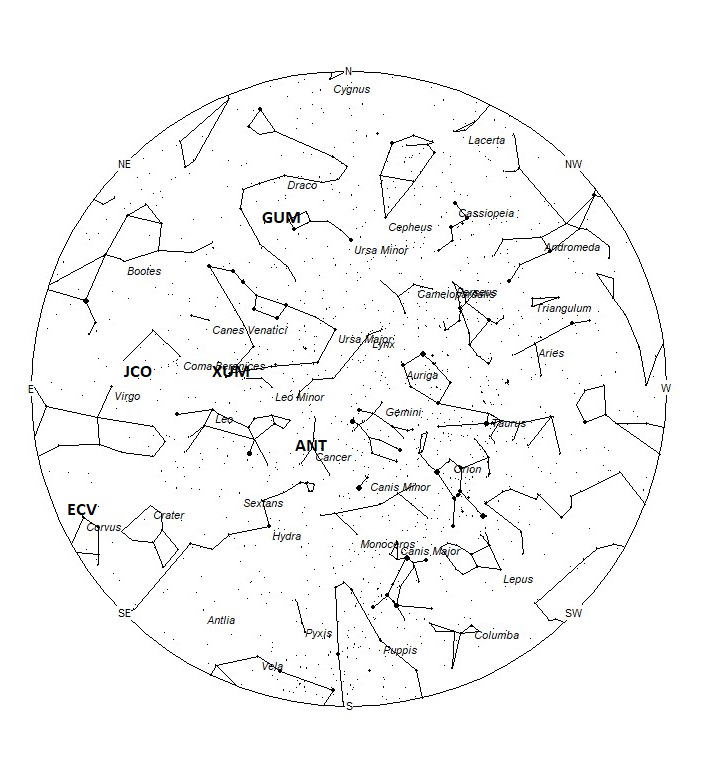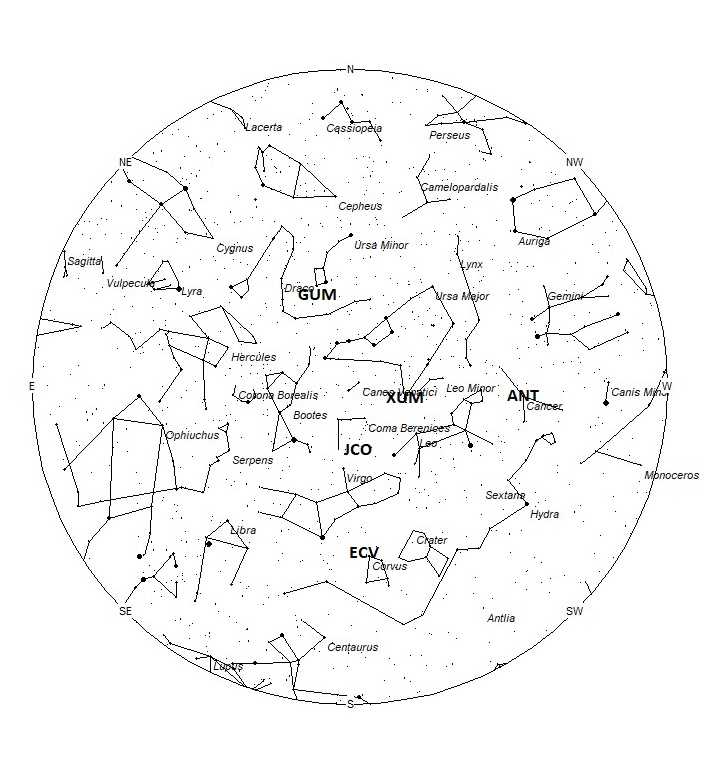
During this period the moon reaches its last quarter phase on Saturday January 18th. At this time the half illuminated moon will rise near 0100 local standard time (LST) and will remain in the sky the remainder of the night. Useful meteor observations are possible at this time as long as the bright moon is kept out of your field of view. Lunar conditions will improve with each passing night as the moon wanes and rises later in the morning. The estimated total hourly meteor rates for evening observers this week is near 3 for those viewing from the northern hemisphere and 2 for those located south of the equator. For morning observers the estimated total hourly rates should be near 9 as seen from mid-northern latitudes (45N) and 8 as seen from tropical southern locations (25S). The actual rates will also depend on factors such as personal light and motion perception, local weather conditions, alertness and experience in watching meteor activity. Morning rates are reduced due to moonlight. Note that the hourly rates listed below are estimates as viewed from dark sky sites away from urban light sources. Observers viewing from urban areas will see less activity as only the brightest meteors will be visible from such locations.
The radiant (the area of the sky where meteors appear to shoot from) positions and rates listed below are exact for Saturday night/Sunday morning January 18/19. These positions do not change greatly day to day so the listed coordinates may be used during this entire period. Most star atlases (available at science stores and planetariums) will provide maps with grid lines of the celestial coordinates so that you may find out exactly where these positions are located in the sky. A planisphere or computer planetarium program is also useful in showing the sky at any time of night on any date of the year. Activity from each radiant is best seen when it is positioned highest in the sky, either due north or south along the meridian, depending on your latitude. It must be remembered that meteor activity is rarely seen at the radiant position. Rather they shoot outwards from the radiant so it is best to center your field of view so that the radiant lies at the edge and not the center. Viewing there will allow you to easily trace the path of each meteor back to the radiant (if it is a shower member) or in another direction if it is a sporadic. Meteor activity is not seen from radiants that are located below the horizon. The positions below are listed in a west to east manner in order of right ascension (celestial longitude). The positions listed first are located further west therefore are accessible earlier in the night while those listed further down the list rise later in the night.
These sources of meteoric activity are expected to be active this week.
.
The large Anthelion (ANT) radiant is currently centered at 08:44 (131) +18. This position lies in central Cancer near the spot occupied by the 4th magnitude star known as Asellus Australis (delta Cancri). Since the radiant is so large, Anthelion activity may also appear from western Leo and eastern Gemini as well as Cancer. This radiant is best placed near 01:00 LST when it lies on the meridian and is highest in the sky. Rates at this time should be near 2 per hour as seen from the northern hemisphere and 1 per hour as seen from south of the equator. With an entry velocity of 30 km/sec., the average Anthelion meteor would be of slow velocity.
The January xi Ursae Majorids (XUM) were discovered by Japanese observers of SonotoCo based on video observations in 2007-2008. This shower is active from January 15-22, with maximum activity occurring on the 18th. At maximum the radiant is located at 11:19 (170) +33, which lies in southwestern Ursa Major, just northwest of the 3rd magnitude star known as Alula Borealis (xi Ursae Majoris). These meteors are best seen near 03:00 LST when the radiant lies highest above the horizon. Hourly rates should be near 1 as seen from the northern hemisphere and less than 1 as seen south of the equator. These meteors encounter the atmosphere at 41 km/sec., which would produce meteors of average velocity.
The eta Corvids (ECV) were recently discovered by Sirko Molau and the IMO Video Meteor Network Team. This stream is active from January 16-29, with maximum activity occurring on the 22nd. The current position of the radiant is 12:38 (189) -16, which places the radiant in northern Corvus only 1 degree northeast of the 4th magnitude star known as eta Corvi. These meteors are best seen near 0400 LST when the radiant lies highest above the horizon. Current hourly rates would be less than 1 per hour no matter your location. At 68 km/sec. these meteors would be fast.
The January Comae Berenicids (JCO) were discovered by Peter Jenniskens and verified by the IMO video network. This source is active from January 21-26 with maximum activity occurring on the 24th. At maximum the radiant lies at 12:52 (193) +15. This area of the sky is located in southern Coma Berenicids, 5 degrees northwest of the 3rd magnitude star known as Vindemiatrix (epsilon Virginis). These meteors are best seen near 04:00 LST when the radiant lies highest above the horizon. Hourly rates are probably less than 1 no matter your location. These meteors encounter the atmosphere at 64 km/sec., which would produce meteors of fast velocity.
The last of the gamma Ursae Minorids (GUM) are expected this weekend. The radiant is currently located at 15:14 (228) +69 which places it southern Ursa Minor, 3degrees south of the 3rd magnitude star known as Pherkad (gamma Ursae Minoris). These meteors are best seen during the last few hours before dawn, when the radiant lies highest in a dark sky. Expected rates may reach 1 per hour as seen from the northern hemisphere and less than 1 as seen from south of the equator. These meteors encounter the atmosphere at 30 km/sec., which would produce meteors of medium-slow velocity.
As seen from the mid-northern hemisphere (45N) one would expect to see approximately 6 sporadic meteors per hour during the last hour before dawn as seen from rural observing sites. Evening rates would be near 2 per hour. As seen from the tropical southern latitudes (25S), morning rates would be near 7 per hour as seen from rural observing sites and 2 per hour during the evening hours. Locations between these two extremes would see activity between the listed figures. Morning rates are reduced by moonlight during this period.
The list below offers the information from above in tabular form. Rates and positions are exact for Saturday night/Sunday morning except where noted in the shower descriptions.
| SHOWER | DATE OF MAXIMUM ACTIVITY | CELESTIAL POSITION | ENTRY VELOCITY | CULMINATION | HOURLY RATE | CLASS |
| RA (RA in Deg.) DEC | Km/Sec | Local Standard Time | North-South | |||
| Anthelion (ANT) | – | 08:44 (131) +18 | 30 | 01:00 | 2 – 1 | II |
| January xi Ursae Majorids (XUM) | Jan 18 | 11:19 (170) +33 | 41 | 03:00 | <1 – <1 | IV |
| eta Corvids (ECV) | Jan 22 | 12:38 (189) -16 | 68 | 04:00 | <1 – <1 | IV |
| January Comae Berenicids (JCO) | Jan 24 | 12:52 (193) +15 | 64 | 04:00 | <1 – <1 | IV |
| gamma Ursae Minorids (GUM) | Jan 18 | 15:14 (228) +69 | 30 | 06:00 | 1 – <1 | IV |
 American Meteor Society
American Meteor Society



I believe to have seen a shooting star in Tinton Falls NJ around 7:15 PM (near the big or Little Dipper), was this possible?
Jan 22,2020
Carol and All,
It’s possible to see meteors on any night of the year from any location. I don’t see any fireball reports from New Jersey at that time so I assume this was an ordinary meteor and not exceptionally bright.
At approximately 2:15am I seen a huge and very fast meteor in Gaston, South Carolina. Lat 33.819374,
London – 81.102280. It was the largest shooting star I have ever seen! Any idea what it was?
Carrie and All,
Your observation sounds like you witnessed a fireball which is a meteor that is larger and brighter than normal. I checked other sightings in SC on that night but none matched up with yours. That is to be expected considering the time of night and the short duration of these objects.
I live in Salem Ct I took my dog outside and saw a shooting go past me in a West north direction very cool
We saw 2 bright incidents the evening of Jan 24th, in different directions . Exciting night.